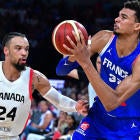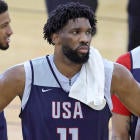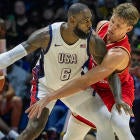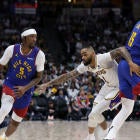After falling in Game 1 on their home floor, everyone was wondering how the Houston Rockets would respond in Game 2 of the Western Conference finals against the Golden State Warriors. As it turned out, the answer was: pretty well!
The Rockets jumped out to a 14-point lead at halftime, led by as many as 29, and coasted to a 127-105 victory. So, understandably, the question that gets asked is, how did they do it? How did the Rockets manage to turn a 13-point loss in Game 1 into a 22-point win in Game 2.
One of the big talking points from Game 1 was Houston's isolation offense. Despite the tremendous success the Rockets have had playing a lot of iso-ball -- they finished with the No. 2 offense in the regular season -- there were questions about whether continuing to go so heavy with that style would be a good strategy moving forward in the series. Even some of Houston's own role players questioned the offensive style. And then there were those who argued the offense was mostly fine, but the real problem was the defense.
The one thing everyone was in agreement about is that the Rockets would need to make some adjustments for Game 2. And they certainly did, as you could tell by just looking at the score. But let's take a closer look at just exactly how the Rockets turned things around, and what lessons they can take from that moving forward.
Unsurprisingly, there wasn't just one answer in the iso-ball vs. defense debate. The Rockets were better in regards to both aspects. While the offense and defense are in part intertwined, as good defense can lead to good offense, let's first just look at some stats.
The Rockets didn't exactly abandon the isolation offense in Game 2. They threw 226 passes in Game 1, compared to 228 passes in Game 2; they didn't all of a sudden just start whipping the ball around the court. In addition, they scored 31 baskets (excluding garbage time) in both Game 1 and Game 2 with either zero or one passes directly leading to the shot attempt.
But in Game 2, the Rockets scored 10 baskets off two or more passes, as compared to just five in Game 1. Here are a few examples. In the first one, Harden gets the ball to Trevor Ariza after a double team, he gets to the middle of the floor, draws the defense's attention, then kicks to Eric Gordon for a 3:
Next, it's just two quick swings to the corner after Harden decided not to use a pick-and-roll, and boom, P.J. Tucker gets a triple:
Then there's the most memorable one, when the Rockets did actually look like the Warriors:
There's nothing crazy going on here. No intricate offensive sets, but the defense has to work, think and react far more than when Harden goes iso and dribbles eight times before launching a step-back 3. And that works a lot! This isn't to say they should stop letting Harden iso, just that Game 2 showed the benefit that can come from getting the ball moving on occasion.
Another area the Rockets improved upon in Game 2 was converting the easier looks they had. They finished 27 of 39 at the rim and 8 of 12 on corner 3s in Game 2, as opposed to 22 of 37 at the rim and 2 of 6 on corner 3s in Game 1. These are two of the most efficient areas to score, and, of course, some of it just comes down to it being a "make or miss league," as Doc Rivers likes to say.
However, the Rockets also helped their cause in this regard by getting out in transition and creating wide-open looks both from 3 and at the rim. They aren't usually a fastbreak team, but in Game 2 they scored 12 fastbreak points, compared to just three in Game 1. Not only are these shots easy, but they also boost players' confidence. Tucker and Ariza combined for nine points in Game 1; both players got easy looks to score in transition in the early stages of Game 2, then went on to combine for 41 points.
And this, of course, is where the defense comes in. You can't get out in transition to get the easy looks unless you get stops -- whether by forcing missed shots or generating turnovers -- on the defensive end first.
So, what do the Rockets do moving forward? While they still need their two stars, Harden and Paul, to lead the way, Game 2 showed that it can be worthwhile to shift a few possessions here and there away from iso-ball to get other players involved. And on the other end, the Rockets' defense will need to play more like they did in Game 2 if they want to steal a game at Oracle to get back home-court advantage. There's no need to revamp their play style or lose sight of what's gotten them to this point, but the little tweaks and adjustments they showed in Game 2 can be valuable the rest of the way.


















